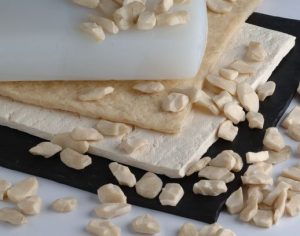
Natural rubber (NR)
The only non-synthetic elastomer in wide use. Characterised by flexibility, strength, resilience and low-temperature resistance as well as excellent physical properties. Possessing good abrasion properties, NR is ideal for bonded rubber/metal products. Not suitable for petrol, grease, oil, and ozone.
EPDM
Versatile in use, very good flexibility, resistant to abrasion, resistant to wear and tear, Excellent weatherability, good high and low-temperature resistance, low gas permeability. Resistant to ozone, steam, water, alcohols, brake fluids. Can be used to protect against washing and spraying agents. Poor resistance to petroleum oils, solvents and mineral oils.
Temperature Range: -15°C to 135°C
Chloroprene Rubber (CR; Neoprene)
Good general purpose elastomer, flame resistant to abrasion, robust dielectric strength with moderate oil, ozone, water, ageing and chemical resistance, good mechanical properties, Resistant to freons, high aniline points oils, mild acids. Not recommended for phosphate esters, ketones, and brake fluids.
Temperature Range: -15°C to 125°C.
Nitrile
Excellent resistance to petroleum products, excellent compression set; resistant to oil, water, silicone greases and oils. Highly resistant to abrasion and tearing, high temperatures. Not recommended for halogenated hydrocarbons, ketones, ozone and sunlight.
Temperature Range: -7°C to 107°C.
SBR
General-purpose elastomer, similar to natural rubber good adhesion to various substrates, good abrasion resistance, good resilience. Resistant to brake fluids, alcohols, water. Not recommended for solvents, oil/gas, sunlight.
Temperature Range: -18°C to 105°C.
Silicone
Best overall temperature Range of elastomers currently available. good insulation properties, odourless and tasteless, non-toxic, can be sterilized in accordance with foodstuffs regulations. Excellent resistance to dry heat, as well as, resistance to low temperature, brake fluids, high aniline point oils.
Resistant to seawater and corrosive salt solutions, not to be used in conjunction with steam, concentrated acids and alkali, swells strongly under the effect of aromatic solvents. Not recommended for some dynamic applications due to poor tensile strength, tear and wear resistance. Poor in petroleum oils and ketones.
Temperature Range: -23°C to 205°C.
Fluorocarbon (FKM; FPM; Viton)
Fluorocarbon has excellent resistance to high temperature and a broad range of chemicals. Permeability and compression set are excellent. Poor low – temperature properties, limited hot – water resistance and shrinkage.
Temperature Range: -50°C to 600°C.
Polyacrylate (ACM)
ACM (Acrylic rubber ) has good resistance to high temperatures, mineral oil, oxygen and ozone.
The water compatibility and cold flexibility are considerably worse than with NBR.
Temperature Range: – 15°C to +175°C.
Butyl rubber (IIR)
Butyl rubber (isobutylene – isoprene rubber or IIR) has a very low permeability rate, good electrical properties, poor short–term rebound, good resistance to heat, oxygen, ozone and many chemicals and solvents, good resistance to abrasion and tear propagation.
Temperature Range:- 20°C to +120°C.
Hydrogenated Nitrile (HNBR; HSN)
High resistance to heat, ozone and oil, good mechanical properties at high temperatures, excellent resistance to oxidation, wear and tear.
Temperature Range: -3°C to 150°C.
Chlorosulphated Polyethylene (CSM)
Flame–resistant, good electric strength, particularly recommended for exposure to sunlight, ozone, weather and oxidizing chemicals, poor tensile strength.
Epichlorohydrin (ECO)
Low gas permeability, very good low-temperature properties, good resistance to mineral oils, ozone and high temperatures.
Polyurethane (PU)
Polyurethane elastomers have excellent wear resistance and tear, high tensile strength and best flexibility with a high shore hardness of all the elastomers. Permeability is good and comparable with butyl, good resistance to oil, not resistant to hydrolysis.
Millable urethanes should not be confused with thermoplastic urethanes, which are generally harder, less flexible, and have slightly better wear resistance.
Temperature Range: -4°C to 80°C.
Fluorosilicone (FVMQ)
Fluorosilicone is silicone polymer chains with fluorinated side–chains for improved oil and fuel resistance. The mechanical and physical properties are very similar to those of silicone.
Temperature Range: -37°C to 175°C.
